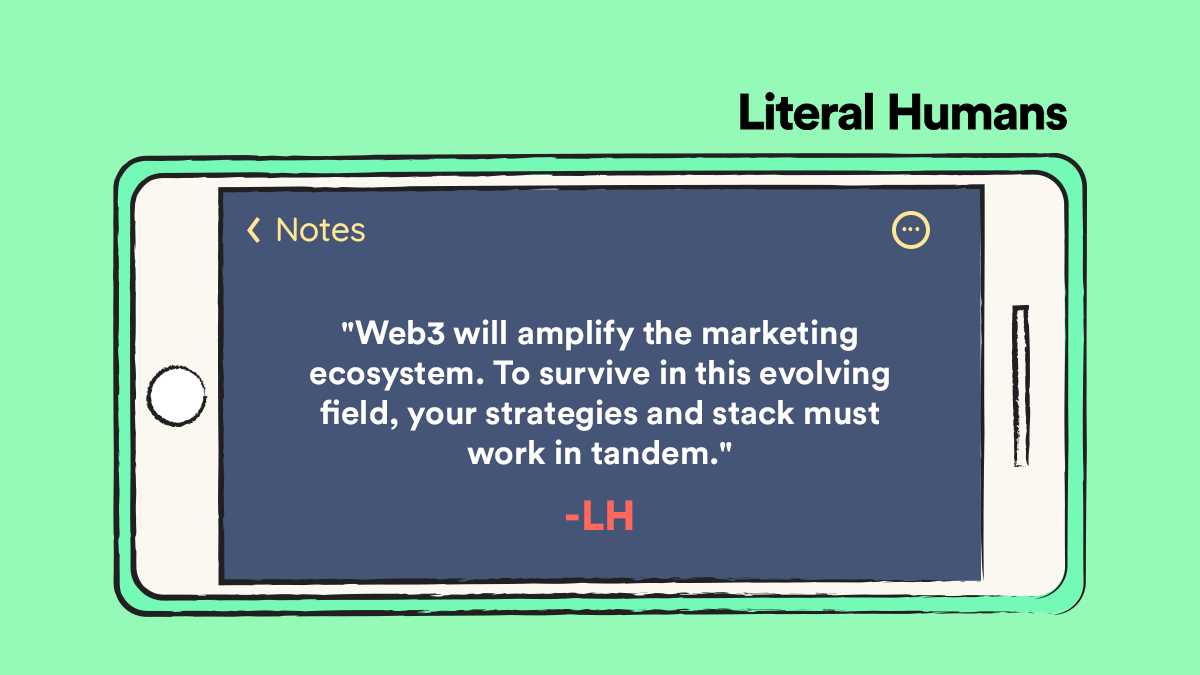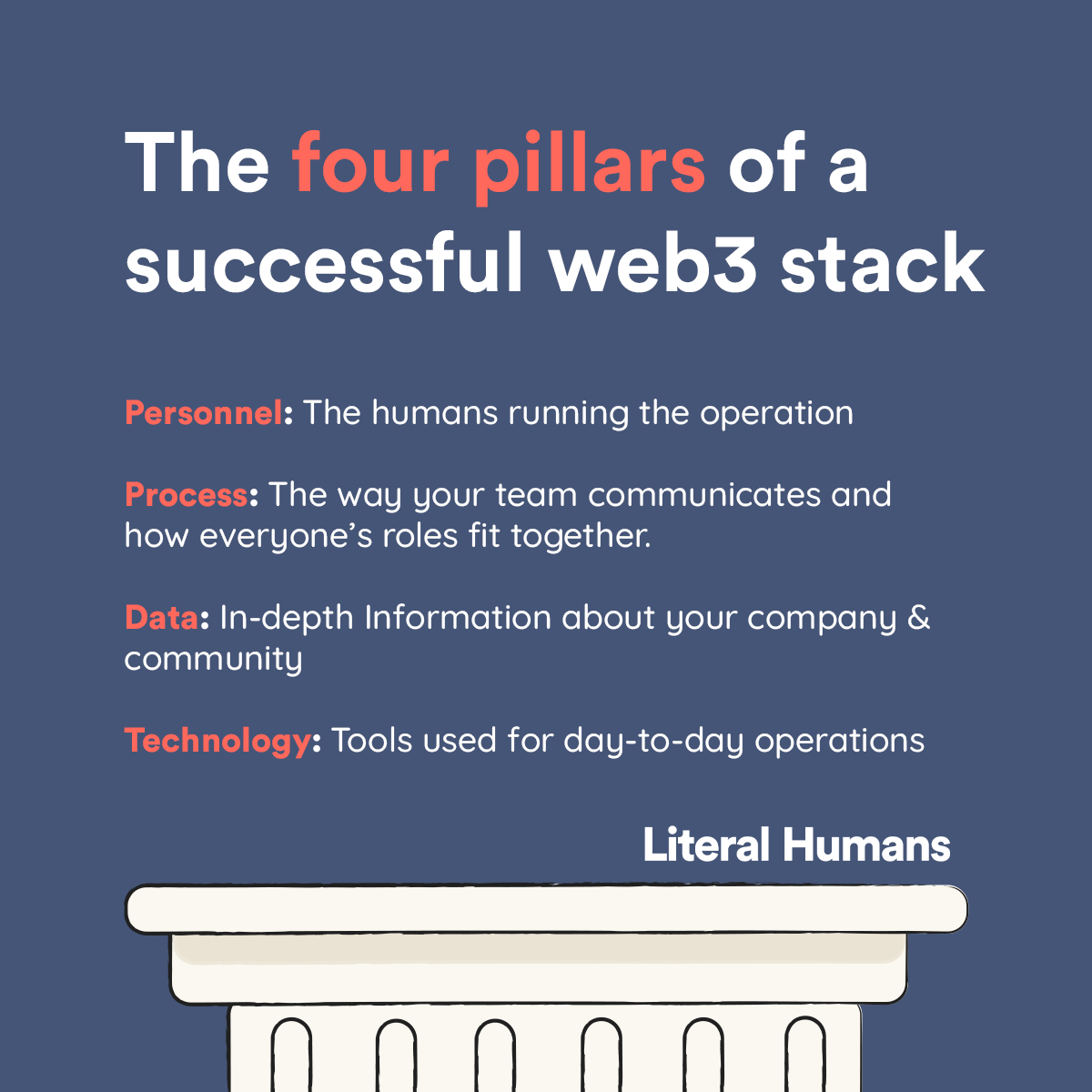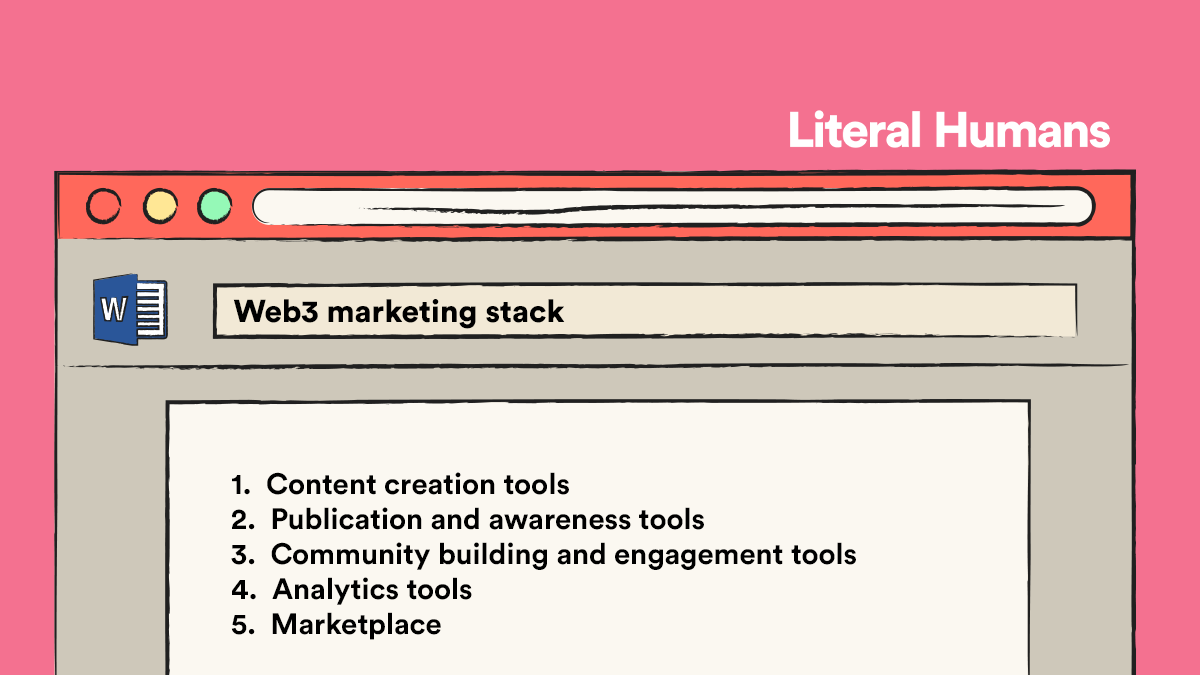Hyper-interactive platforms, artificial reality devices, and the decentralized internet called Web3 all continue to develop at lightning speed today.
In this context, the need to augment your business and connect with your community is paramount.
If the centralized internet has taught us anything, it’s that evolving your marketing to fit in with the current climate is key. To avoid pulling out your hair trying to connect with your community in this climate, you need a reliable marketing stack primed for Web3.
Stacks help to ease and automate the marketing process. With Web2 marketing stacks, all you have to do is find what works for you and dive in. The same cannot be said for Web3 because only a handful of tools are currently developed for marketing in Web3.
The best way to your ideal Web3 marketing stack will always involve connecting with Web3 marketing teams and experimenting with tools that help create, connect and communicate with the community. That said, we have a few strategies and recommendations that might help you along the way.

What is Web3 marketing?
Web3 marketing is the process of communicating your brand or business in a decentralized environment. For Web3 and blockchain-based projects to thrive, marketing teams will need to spend more to acquire users efficiently and build a community around them.
Web2 marketing employs the use of cookies as the primary identifier of a person as opposed to Web3’s uses of wallets. No bridge connects Web2 & Web3 data yet. Instead, behavioral patterns in Web3 are driven by anonymity and communication patterns on platforms like Discord and Telegram.
At the moment, businesses can still rely on centralized stacks. But when the switch happens, existing marketing technologies won’t work for Web3.
What is a marketing stack?
A marketing technology stack is a gathering and grouping of technologies that marketers create and leverage to improve their marketing activities. The focus of marketing technologies, i.e. martech, is to ease the digital marketing process, measure the impact of marketing activities and drive more efficient spending by seeing how your marketing strategy works in tandem with your stack.
Since your strategy will inevitably involve either starting a web3 business/project or transitioning into one, understanding what Web3 is and how to market your business in it is the first step to take before pairing it with a stack.

Pillars of a successful Web3 stack
Whether centralized or decentralized, every business needs pillars that will become the foundation of its successful marketing stack. We recommend the following pillars for a web3 marketing stack in order of importance:
1. Personnel
This refers to the humans in your team or company. They require training, interest, and organization to be successful in their roles. Sounds simple enough? It’s still an often-overlooked step.
Taking apps into consideration, there will need to be administrators, and cross-team ‘ambassadors.’ It’s important to identify these people and make sure that everyone is clear about their roles and responsibilities.
You should also closely monitor new talent as you recruit it in the Web3 space. Rather than throwing new hires straight into the deep end, build an organized process of onboarding and training personnel. Adding and removing people is a part of change management and is critical when evaluating what goes into your Web3 stack.
2. Processes
Before talking about technology/tools, we need to identify processes and understand how everyone’s roles fit together. This way, the technology you eventually adopt, you’ll adopt with a purpose.
Having conversations with your team and potential users in meetings and product tests is a great way to understand how in-house and outside parties view your product. This always brings new insight into what’s done well and what could be done better.
Even if you run a large business and all you need is a smooth transition into the Web3 space, organizing meetings around necessary processes can help your teams and get to understand how the data and new technology will fit their needs and systems—especially for team members who will be your day-to-day users.
To do this effectively, platforms like Slack, Trello, and Asana are great for communication, assigning tasks, and collaboration.
3. Data
Data makes the centralized world spin. However, in the web3 world, user data won’t be driven by users simply accepting cookies. It’s important to refocus your efforts on creating a connection with your users on a deeper level. Try to also discover which members of your team need the data, what data is most relevant, and how data can be shared within the team seamlessly.
This needs to include standardizing how new data needs to enter your organization, how data is washed or maintained, and where it’s stored. In Web2, this can be on public or private clouds. In Web3, it’s all on the blockchain.
4. Technology
Before jumping onto any technology, your personnel, process, and data have to all be in sync, organized, and well-documented. This must be understood and shared among all the admins on your team. Making sure the processes mentioned previously are in order will help your team save effort, avoid unnecessary tool purchases, and keep everyone on the same page.
Examine what your team is familiar with and what new tools will be effective from your team’s viewpoint (not the vendor’s!). Consider what new tools need to be integrated, and outline how their value will be connected to your personnel, process, and data. By starting with defining your process and people, you will steer clear of technology that looks good but doesn’t fit your team or needs.
Now that you’ve established the pillars that make a stack successful, it’s time to actually start picking your stack.
We’ve created the ideal marketing Stack for any blockchain-based project.
Web3 marketing might be relatively new, but stacks are not.
The following marketing stacks developed specifically web3 have made automation, communication, and publication easier than ever. So we decided to chuck them into a list and built the ultimate Web3 marketing stack to ease your business’s big change.

The top elements that make up a web3 marketing stack
In 2021, over 7000 apps were apps available for marketing teams. The rapid proliferation and adoption of SaaS apps have made centralized businesses reach audiences wide. And although they’re centralized, some of them still play a role in decentralized marketing.
1. Content creation tools
Creating content in Web3 goes beyond writing blog posts and creating designs. Although content creation is undoubtedly an important part, other elements, such as using NFTs, play an equally significant part when it comes to communicating your brand.
Building and deploying NFT projects has been trendy, effective, and relatively straightforward (for artists and technical creators) lately, with 2022 seeing more high-profile brands and individual creators dive into Web3 through unique and memorable NFTs.
The global crypto market is worth $3 billion according to Beincrypto, and is estimated to quadruple by 2030. That means more and more people are making NFTs as art pieces or for the Metaverse. Although artists can use in-app NFT creators on marketplaces or NFT generators, platforms like Adobe Illustrator, Photoshop, SketchAR and Blender are more technical and produce better-quality works.
To create content that will market these products on social media, graphic ads, and video content platforms like Canva, Lumen5, Adobe Premiere, Infogram are top choices. To manage content, WordPress our top pick. Writing, editing, and plagiarism checks are best done on Google Suites and Grammarly.
2. Publication and awareness tools
Once your content is created, the next step will be to get it in front of the right people. Getting your business in front of potential users/customers allows them to be part of your community, so it’s crucial to have engaging content built around a valuable product.
Facebook, Twitter, Instagram, YouTube, and Reddit are the behemoths of the centralized world, and 99% of the world’s population is on at least one of these platforms. The point here is to reach a centralized audience and make them aware of the possibilities of Web3. So when you transition them, you’ll have your loyal users packed and ready to go.
Start by distributing relevant and incentivized content. The incentive could be monetary (coins or tokens), giveaways (NFTs or Whitelist spots), or industry-based or product-based education (web3 webinars or any form of virtual structured education).
Next comes the community-building and engagement phase. This phase is vital, because your business is contingent on how well you cater to your community’s needs. Having an in-app blog works best, but Medium or Mirror are easy web3 online content publishing platforms to publish content. For distributing content, it’s best to use Buffer, Hubspot (email), Twitter, Instagram, Reddit and Coinmarketcap.
3. Community building and engagement tools
Whether you’re launching an NFT collection, starting a blockchain-based business, or transitioning from Web2 to Web3, communicating and connecting with your community is the only way you’ll succeed.
Community building involves connecting a brand to a particular community, using a platform to communicate, exchange values, and create mutual meaning.
Brands do not have to start from scratch; they can decide to work with established groups. Community-building requires marketers to start conversations, establish opportunities for connection (through events, giveaways, or exclusive access) and create purposeful traditions. Platforms like Discord and Telegram have been prominent for communication between projects and community members.
Why is community building and engagement so important?
-
Better user experience
Web3 products almost always make use of complex infrastructure, and this makes understanding them a tedious task. But when community engagement is done correctly, you begin to have a better understanding of what your customers find difficult to understand. When you constantly interact with your community, they provide key insight into your product.
Bread-and-butter activities such as fielding complaints, gathering product feedback, and nurturing advocates and ambassadors will help creators know what’s working and what’s not. The insights they provide will serve as a goldmine of information that can guide your brand to delivering easy-to-understand, relevant and valuable content.
-
Relevance and loyalty
In the current Web3 ecosystem, your users, audience, and customers are even more valuable than before. Community building allows you to inspire customers to continue to purchase and show loyalty to your product. Marketers have a hard time building loyalty in the Web3 space because of the characteristic instability. However, the ultimate key to guaranteeing loyalty is to provide true value in an open environment. This can help cut down advertising costs, build brand equity and increase valuation.
-
Customer and brand humanization
Remarkable crypto projects emerge every day, but they’re often paired with hollow and inauthentic marketing due to a robotic communication style.
Good community building for Web3 solves problems by putting the power in the hands of the community members themselves. When this happens, you get valuable feedback and posts, authentic user-generated content (UGC), and a special connection to your project. Customers become unconscious ambassadors, marketing you through word of mouth and the occasional Twitter post. The result is a more authentic, unique, and human experience for fans.
4. Analytics tools
The value of closely and regularly analyzing data is unquestionable. And that’s why your data needs to be kept locked and loaded.
If you’re running a simple and small operation like NFT collection or anything in that regard, hiring a data analyst is not exactly cost-effective. Instead, Google search console and Google Analytics are surefire ways to accurately monitor a business’s social and search temperature at affordable rates.
On the other hand, if your business is full-scale with serious day-to-day operations, then a data analyst would play a huge role for you, supported by Google Analytics, Google Search Console and Hotjar that provide accurate data and useful insights daily.
5. Marketplace
Marketing non-fungible tokens (NFTs) deviates a little from the norm because of their need for a special marketplace. An NFT marketplace is a digital platform for buying, selling, and trading NFTs. These platforms allow people to store and display their NFTs and sell them for cryptocurrency or money.
Play-to-earn (P2E) metaverse games take this into account because of the NFT elements in their game. These games often use NFTs as skins, avatars, vehicles, spaceships, etc. depending on your type of game. Marketplaces like Opensea, Magic Eden, Coinbase NFT, etc. are great marketplaces to look into when considering gas fees, accessibility, and popularity.

Build a winning Web3 marketing stack today
To build a killer Web3 marketing stack, it’s important to understand that many Web3 projects struggle to get their business in front of their audience because they are overly complex. They also have disconnected and disorganized teams and workflow.
A robust Web3 marketing stack can help you find value in the journey of creating for the future rather than take the stress of it. It can also help advance the way your teams produce content, deliver content and interact with your community.
The sooner you begin to integrate a Web3 marketing stack into your content plan, the better prepared you’ll be able to reach your audiences in this space. Interested in building a winning marketing stack for the decentralized future? Schedule a strategy session with us today.









